四级深度阅读
英语四级深度阅读技巧

题材评述
经济商贸 2006.12 瓶装水的成功推广 2008.12 商店如何应对顾客投诉 生命健康 2006.12 健康新解 2008.12 男性比女性更易得病 社会生活 2008.6 保护隐私 2007.12 子女教育 2009.12 美国黑人女性形象 2010.6 正面思维与负面思维 2010.12 人们工作角色转变的原因 婚姻与长寿
长难句
实用的原则: 修饰成分全找出来之后, 用括号把每个修饰成分括起来,留在括号 外面的就是主干. 然后,按照一般顺序, 谓语在前,宾语(或表语)在后,这样我 们就有了主谓宾(或主系表)的主干结构 了.最后把修饰成分按对应的位置加上去, 整个句子的结构就把握住了。
长难句常涉及的类型
1.双重否定句 负负得正,把两个表示否定的结 构都去掉。No, not, hardly,seldom,never little, few, small 应注意的词根词缀 de-/dis-/un/inThere are probably no questions (that)we can think up that can‘t be answered, sooner or later, including even the matter of consciousness. Answer: Man can find solutions sooner or later to whatever questions concerning nature he can think up.
篇章阅读
------寻找可能的技巧
阅读理解
新四级考试的阅读部分主要分为快速阅读和深度(仔细) 阅读两个部分。深度阅读包括选词填空与题意选择两种题 型, 阅读分数占全卷的35%.
英语四级深度阅读技巧

Fiction and non-fiction books can be excellent sources for deep reading. They allow readers to explore themes, characters, and stories in more depth than other sources.
Plot summary
Analyze the characteristics and traits of a given character in a passage.
Character analysis
Identify the causes and effects of events or situations described in a passage.
Quick reading skills
Speed reading: It is an essential skill for deep reading, allowing students to quickly scan and understand the general idea of the article.
Culture and the arts
Articles about culture and the arts often delve into the meanings and interpretations of works of art, music, film, and literature. They require a nuanced understanding of the subject matter.
contents
目录
最新四级深度阅读理解做题技巧四级深度阅读是哪几题通用
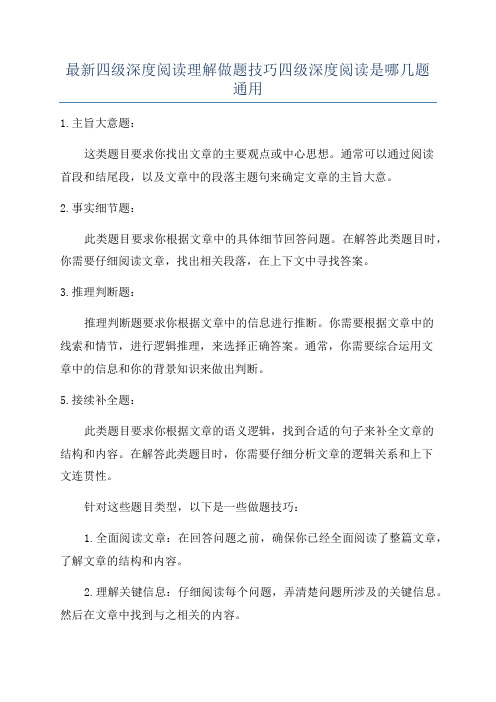
最新四级深度阅读理解做题技巧四级深度阅读是哪几题通用1.主旨大意题:这类题目要求你找出文章的主要观点或中心思想。
通常可以通过阅读首段和结尾段,以及文章中的段落主题句来确定文章的主旨大意。
2.事实细节题:此类题目要求你根据文章中的具体细节回答问题。
在解答此类题目时,你需要仔细阅读文章,找出相关段落,在上下文中寻找答案。
3.推理判断题:推理判断题要求你根据文章中的信息进行推断。
你需要根据文章中的线索和情节,进行逻辑推理,来选择正确答案。
通常,你需要综合运用文章中的信息和你的背景知识来做出判断。
5.接续补全题:此类题目要求你根据文章的语义逻辑,找到合适的句子来补全文章的结构和内容。
在解答此类题目时,你需要仔细分析文章的逻辑关系和上下文连贯性。
针对这些题目类型,以下是一些做题技巧:1.全面阅读文章:在回答问题之前,确保你已经全面阅读了整篇文章,了解文章的结构和内容。
2.理解关键信息:仔细阅读每个问题,弄清楚问题所涉及的关键信息。
然后在文章中找到与之相关的内容。
3.寻找线索:注意文章中的线索和关键词,它们可以帮助你找到答案所在的段落和句子。
4.上下文理解:在阅读相关段落时,要注意上下文的语境和逻辑关系。
上下文的信息经常能够提供答案所需的背景信息。
5.根据文章整体理解答案:在回答问题时,要考虑文章的整体内容和主题,避免过于片面的理解。
6.划掉干扰选项:仔细比较选项之间的差异,找出干扰选项并将其排除,然后再做出选择。
综上所述,对于最新四级深度阅读理解部分的各类题型,掌握上述做题技巧可以帮助你更好地完成阅读理解部分的试题。
但请注意,考试内容会根据不同考试版次有所调整,请以具体考试要求为准。
四级A卷深度阅读答案解析

四级A卷深度阅读答案解析四级深度阅读section A文章大意:关注的是绿色建筑与对待现存房屋的问题。
依据文意,所谓绿色建筑即为节能减排的建筑。
绿色建筑在节能减排方面意义重大,但是将全部现存房屋替换成绿色建筑是否可行呢?文章给出的答案是不行行的,由于推倒这些房屋进行重建也需要大量能量。
那么,如何处理这些能耗大的旧房屋呢?文末给出的建议是对它们进行整修和升级。
47. G incredibly首先这里需要的是一个副词。
依据文意,将这些房屋推倒代之以绿色建筑是极度铺张的。
因此选incredibly.48. K replacereplace A with B, 意思是用B 替换A. 这里是用绿色建筑取代现存房屋。
49. J reduced这一句话较难理解,翻译成中文即:绿色建筑带来的碳排放量的削减平均需要65年才能够补偿推倒房屋所用掉的能量。
reduced, 这里用作形容词,指削减了的。
50. L sensein the broadest sense, 在最广义上,这里是一个固定搭配。
51. H powering这里的引导的是平行结构,因此横线上需要填入一个动词的ing形式。
在依据句意可知这里选powering,指为某物供应动力,使某物得以运行。
52. D exceptions联系下文可知本段意思是老房子基本上是最不节能的。
但话不能说得这么肯定,因此用with some exceptions, 指除一些特别状况外。
53. E expand:/tiny cracks and gaps 指的是小的缝隙和缺口。
小的缝隙和缺口随着时间消逝,会扩大,从而使得外面空气流入,因而加大了能耗。
这里选expand表示扩展,增大。
54. O vasta number of 表示大量的,number前面可加一些形容词,如great等,表示数量极大的。
这里填入vast,意为数量巨大的。
55. F historic句中有from to , 从什么到什么,联系整句话,意思是从一些历史上的古老建筑到你自己的战后的房子。
四级深度阅读
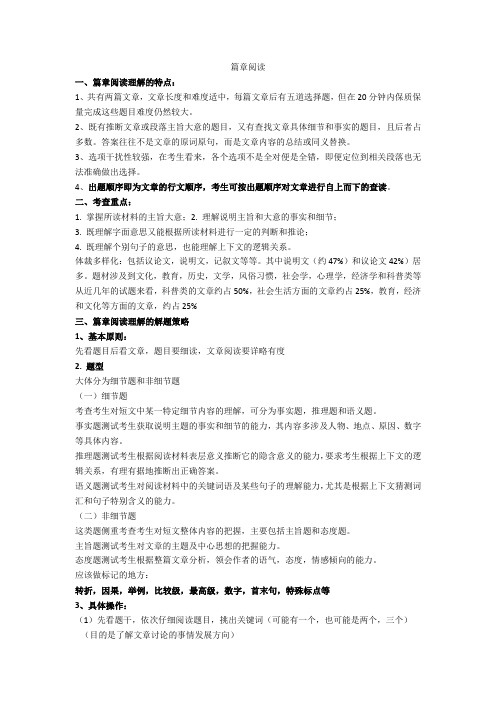
篇章阅读一、篇章阅读理解的特点:1、共有两篇文章,文章长度和难度适中,每篇文章后有五道选择题,但在20分钟内保质保量完成这些题目难度仍然较大。
2、既有推断文章或段落主旨大意的题目,又有查找文章具体细节和事实的题目,且后者占多数。
答案往往不是文章的原词原句,而是文章内容的总结或同义替换。
3、选项干扰性较强,在考生看来,各个选项不是全对便是全错,即便定位到相关段落也无法准确做出选择。
4、出题顺序即为文章的行文顺序,考生可按出题顺序对文章进行自上而下的查读。
二、考查重点:1. 掌握所读材料的主旨大意;2. 理解说明主旨和大意的事实和细节;3. 既理解字面意思又能根据所读材料进行一定的判断和推论;4. 既理解个别句子的意思,也能理解上下文的逻辑关系。
体裁多样化:包括议论文,说明文,记叙文等等。
其中说明文(约47%)和议论文42%)居多。
题材涉及到文化,教育,历史,文学,风俗习惯,社会学,心理学,经济学和科普类等从近几年的试题来看,科普类的文章约占50%,社会生活方面的文章约占25%,教育,经济和文化等方面的文章,约占25%三、篇章阅读理解的解题策略1、基本原则:先看题目后看文章,题目要细读,文章阅读要详略有度2. 题型大体分为细节题和非细节题(一)细节题考查考生对短文中某一特定细节内容的理解,可分为事实题,推理题和语义题。
事实题测试考生获取说明主题的事实和细节的能力,其内容多涉及人物、地点、原因、数字等具体内容。
推理题测试考生根据阅读材料表层意义推断它的隐含意义的能力,要求考生根据上下文的逻辑关系,有理有据地推断出正确答案。
语义题测试考生对阅读材料中的关键词语及某些句子的理解能力,尤其是根据上下文猜测词汇和句子特别含义的能力。
(二)非细节题这类题侧重考查考生对短文整体内容的把握,主要包括主旨题和态度题。
主旨题测试考生对文章的主题及中心思想的把握能力。
态度题测试考生根据整篇文章分析,领会作者的语气,态度,情感倾向的能力。
英语四级深度阅读作文模板
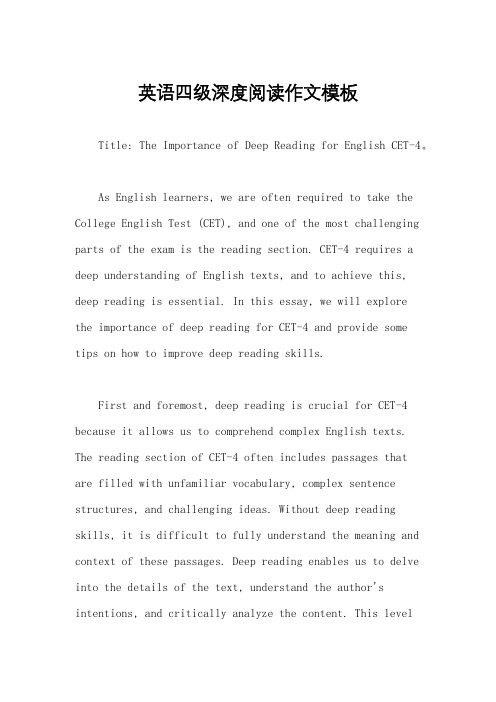
英语四级深度阅读作文模板Title: The Importance of Deep Reading for English CET-4。
As English learners, we are often required to take the College English Test (CET), and one of the most challenging parts of the exam is the reading section. CET-4 requires a deep understanding of English texts, and to achieve this, deep reading is essential. In this essay, we will explorethe importance of deep reading for CET-4 and provide some tips on how to improve deep reading skills.First and foremost, deep reading is crucial for CET-4 because it allows us to comprehend complex English texts. The reading section of CET-4 often includes passages that are filled with unfamiliar vocabulary, complex sentence structures, and challenging ideas. Without deep reading skills, it is difficult to fully understand the meaning and context of these passages. Deep reading enables us to delve into the details of the text, understand the author's intentions, and critically analyze the content. This levelof understanding is necessary for answering comprehension questions and writing essays based on the passages.Furthermore, deep reading enhances our language proficiency and vocabulary. When we engage in deep reading, we encounter a wide range of vocabulary and languagepatterns that we may not come across in daily conversations or casual reading. By immersing ourselves in the text and paying attention to the nuances of language, we can expand our vocabulary and improve our language skills. This is particularly important for CET-4, as the exam requires a strong command of English vocabulary and grammar.In addition, deep reading cultivates critical thinking and analytical skills. When we read deeply, we are encouraged to think critically about the text, ask questions, and make connections between different ideas. This level of engagement with the material helps us develop analytical skills that are essential for CET-4. In the exam, we are often required to analyze and evaluate the arguments presented in the passages, and deep reading equips us with the ability to do so effectively.To improve our deep reading skills for CET-4, there are several strategies that we can employ. Firstly, it is important to read actively and attentively. This means paying close attention to the details of the text, such as the main ideas, supporting evidence, and the author's tone. Actively engaging with the material will help us grasp the content more thoroughly. Secondly, it is beneficial to annotate the text while reading. This involves underlining key points, making notes in the margins, and highlighting important passages. Annotating the text helps us to better remember and understand the content. Additionally, it is helpful to engage in discussions or join study groups to exchange ideas and interpretations of the text. This allows us to gain different perspectives and deepen our understanding of the material.In conclusion, deep reading is essential for success in the reading section of CET-4. It enables us to comprehend complex texts, improve language proficiency, and develop critical thinking skills. By actively engaging with the material and employing effective reading strategies, we canenhance our deep reading skills and perform better on the exam. Therefore, it is crucial for English learners to prioritize deep reading in their preparation for CET-4.。
英语四级考试深度阅读课件

01
02
定位答案位置需要同义替换意识
得出正确答案需要同义替换意识 解决办法:背单词时注意英文解释 English → English
Tip B. 加强同义替换意识
同义替换举例
例:The success of Bill Gates and other non-MBAs, such as the late Sam Walton of Wal-Mart Stores Inc., has helped inspire self-conscious debates on business school campuses over the worth… Q. it seems that the controversy over the values of MBA degrees has been fueled by __________. Controversy---debate fueled---inspired
负负得正—出现两个表示否定的结构则都去掉。 ★应注意的否定词:No, not, hardly, seldom, never little, few, small
应注意的否定词缀 : de-/dis-/un-/in-
2
例:There are probably no questions (that)we can think up that can’t be answered, sooner or later, including even the matter of consciousness.
长难句举例
A breakthrough ﹝in the provision of energy from the sun for the European Economic Community (EEC) ﹞ could be brought forward ﹝ by up to two decades, if a modest increase could be provided in the EEC’s research effort in this field, according to senior EEC scientists engaged in experiments in solar energy at EEC’s scientific laboratories at Ispra, near Milan. ﹞
英语四级深度阅读的答题技巧
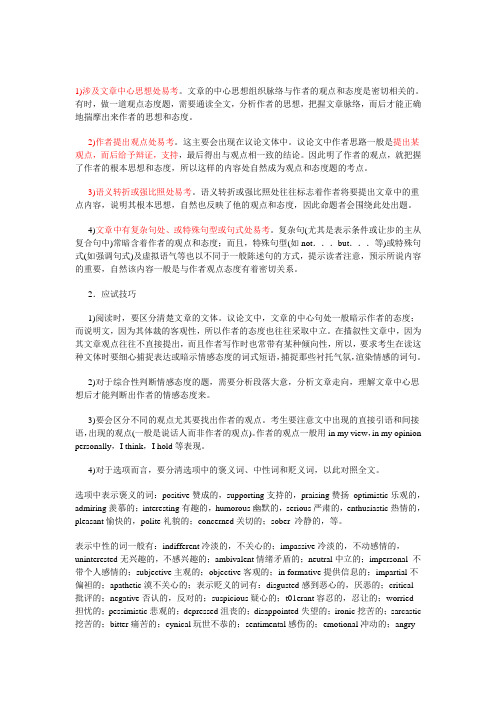
1)涉及文章中心思想处易考。
文章的中心思想组织脉络与作者的观点和态度是密切相关的。
有时,做一道观点态度题,需要通读全文,分析作者的思想,把握文章脉络,而后才能正确地揣摩出来作者的思想和态度。
2)作者提出观点处易考。
这主要会出现在议论文体中。
议论文中作者思路一般是提出某观点,而后给予辩证,支持,最后得出与观点相一致的结论。
因此明了作者的观点,就把握了作者的根本思想和态度,所以这样的内容处自然成为观点和态度题的考点。
3)语义转折或强比照处易考。
语义转折或强比照处往往标志着作者将要提出文章中的重点内容,说明其根本思想,自然也反映了他的观点和态度,因此命题者会围绕此处出题。
4)文章中有复杂句处、或特殊句型或句式处易考。
复杂句(尤其是表示条件或让步的主从复合句中)常暗含着作者的观点和态度;而且,特殊句型(如not...but...等)或特殊句式(如强调句式)及虚拟语气等也以不同于一般陈述句的方式,提示读者注意,预示所说内容的重要,自然该内容一般是与作者观点态度有着密切关系。
2.应试技巧1)阅读时,要区分清楚文章的文体。
议论文中,文章的中心句处一般暗示作者的态度;而说明文,因为其体裁的客观性,所以作者的态度也往往采取中立。
在描叙性文章中,因为其文章观点往往不直接提出,而且作者写作时也常带有某种倾向性,所以,要求考生在读这种文体时要细心捕捉表达或暗示情感态度的词式短语,捕捉那些衬托气氛,渲染情感的词句。
2)对于综合性判断情感态度的题,需要分析段落大意,分析文章走向,理解文章中心思想后才能判断出作者的情感态度来。
3)要会区分不同的观点尤其要找出作者的观点。
考生要注意文中出现的直接引语和间接语,出现的观点(一般是说话人而非作者的观点)。
作者的观点一般用in my view,in my opinion personally,I think,I hold等表现。
4)对于选项而言,要分清选项中的褒义词、中性词和贬义词,以此对照全文。
大学英语四级深度阅读题及详解
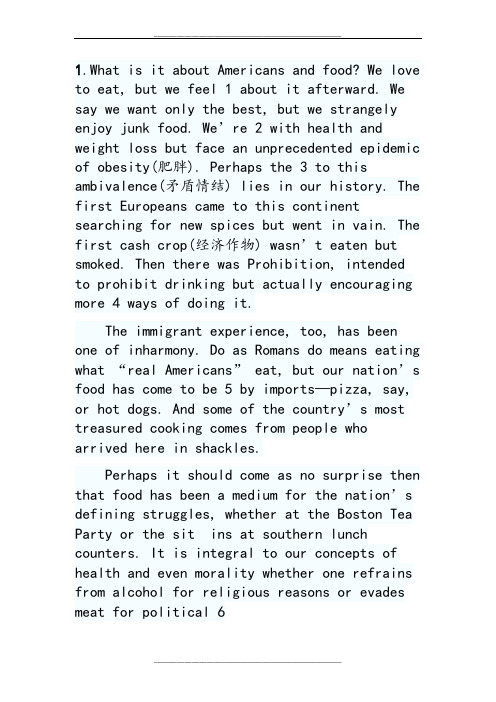
1.What is it about Americans and food? We love to eat, but we feel 1 about it afterward. We say we want only the best, but we strangely enjoy junk food. We’re 2 with health and weight loss but face an unprecedented epidemic of obesity(肥胖). Perhaps the 3 to this ambivalence(矛盾情结) lies in our history. The first Europeans came to this continent searching for new spices but went in vain. The first cash crop(经济作物) wasn’t eaten but smoked. Then there was Prohibition, intended to prohibit drinking but actually encouraging more 4 ways of doing it.The immigrant experience, too, has been one of inharmony. Do as Romans do means eating what “real Americans” eat, but our nation’s food has come to be 5 by imports—pizza, say, or hot dogs. And some of the country’s most treasured cooking comes from people whoarrived here in shackles.Perhaps it should come as no surprise then that food has been a medium for the nation’s defining struggles, whether at the Boston Tea Party or the sit ins at southern lunch counters. It is integral to our concepts of health and even morality whether one refrains from alcohol for religious reasons or evades meat for political 6But strong opinions have not brought 7 . Americans are ambivalent about what they putin their mouths. We have become 8 of our foods, especially as we learn more about what they contain.The 9 in food is still prosperous in the American consciousness. It’s no coincidence, then, that the first Thanksgiving holds the American imagination in such bondage(束缚).It’s wha t we eat—and how we 10 it with friends, family, and strangers—that help define America as a community today.A. answer I. creativeB. result J. beliefC. share K. suspiciousD. guilty L. certaintyE. constant M. obsessedF. defined N. identifyG. vanish O. idealsH. adapted【答案及详解】1. D feel是一个系动词,可以判断此处应填入一个形容词,通过上下文意思,以及后面介词about, 可以确定选项为D项guilty, 短语feel guiltyabout sth. “对……感到有愧”。
CET4英语四级深度阅读技巧.ppt

There is no success without hardships 没有磨难,就没有胜利。 (不经历风雨,怎能见彩虹。)
There exists no language or dialect in the world that cannot convey complex ideas.
读完第一段做第一题,做完第一题读第二题,带着问题去读第二段 优点:符合题文同序的出题原则 缺点:不适合主旨题和全文态度题 两者结合: 1.略读全文,把握文章大意 2m (将注意力放在文章的主题句、关联 词等部分。其余内容如具体论述、细节、数字等则可以跳过不读。) 2. 根据题干中的关键词定位原文 3.以原文为依据,进行同义替换、判断推理。
家庭犯罪等。
❖ 经济问题
❖ 体育——与社会发展相关 ❖ 个人发展史——夹叙夹议,与文学、历史相关。
考题要求
深度阅读中篇章阅读 考查考生要点(大纲决定考点)
❖ 1. 掌握主旨要义 ❖ 2. 了解文中具体信息 ❖ 3. 根据所读材料进行有关的判断、推理和引申 ❖ 4. 理解作者的意图、观点或态度 ❖ 5. 依据上下文推测生词的词义,理解个别(重点)
❖ 体裁方面 1. 议论文 2. 说明文 3. 新闻评述 4. 记叙文
❖ 题材方面 1. 人文科学 2. 自然科学
❖ 阅读多为说明文、议论文,有时也会出现记叙文,但讨论 的多数是社会问题,不会有很强的个人写作风格和传记色 彩。
❖ 关注热点问题
❖ 环保问题
❖ 新科技的发展——网络、电子、医学等 ❖ 社会类问题——性别歧视、子女教育、文化差异、失业率、
英语四级深度阅读专项讲解
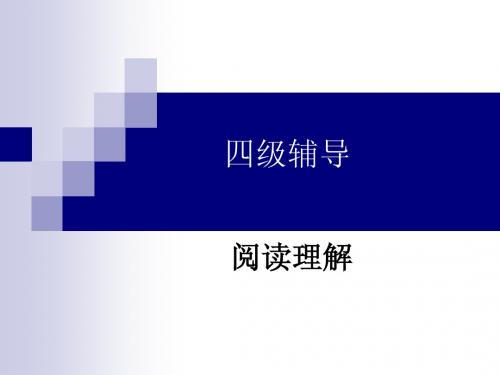
解题技巧: 切忌凭主观臆断, 必须是基于文章中的具体事实细节进行。 虽然在文章中不能直接找到答案, 但是一定要在文章中找到推测的依据进行 合理严密的推断。
如果是针对文章中的某个细节进行推断, 就要先在文章中找到该细节所在的句子,在正确理 解该句的基础上推断出未知的事实。 如果是根据文章推测作者的观点、目的、态度和思 路, 应该首先确定文章的中心思想,然后根据中心和 作者所陈述的事实及细节进行推断。 如果要是推断文章中没出现的前一段或下一段的内 容, 应在仔细阅读并理解了文章内容的基础上,重点 分析文章的首、尾两段尤其是文章的开始句和结束 句。 针对文章人物性格的推断在考试中不太常见,但是 对于人物性格的分析有助于理解作者的观点,因此, 在阅读中要注意对人物的语言、动作、行为等的描 述。
四级辅导
阅读理解
阅读理解的选材与体裁
选材:社会生活、经济、教育、文化、科普、等 方面。一般以社会生活和经济为主。 2. 体裁:议论文,说明文,叙述文,描述文。一般 以议论文和说明文为主。 3. 特点: (1)说明文为主,兼议论 (2)最新国外报刊新闻 (3)词汇量大、并有专有名词【这是四级考试文章最 大变化之一】 (4)文章显著增长,须圈点阅读
(1)主题词是全文中心讨论的事物。 (2)文章的主题句:首段或尾段,中间段落。 段落的主题句:段首或段尾,有时也在段 落的中间。 全文开头主题句标志: 1.全文开头作者明确下结论、表立场的句子; 2.全文开头引言后的解释; 3.全文开头转折后的理论观点; 4.全文开头故事背景后引出的第一个理论观 点
2.细节题
2.细节题:出现频率最高。 文章的某个具体细节如:时间、地点、人 物、原因、结果、条件、现象等。 标志:题干较长,包含很多细节信息。
英语四级深度阅读试题
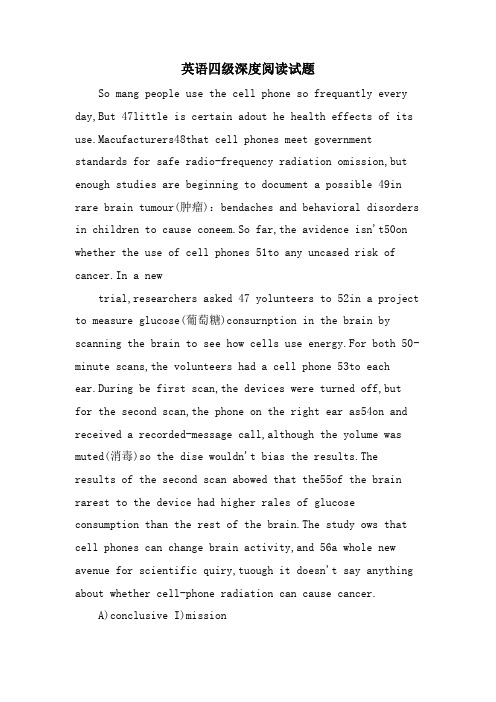
英语四级深度阅读试题So mang people use the cell phone so frequantly every day,But 47little is certain adout he health effects of its use.Macufacturers48that cell phones meet government standards for safe radio-frequency radiation omission,but enough studies are beginning to document a possible 49in rare brain tumour(肿瘤):bendaches and behavioral disorders in children to cause coneem.So far,the avidence isn't50on whether the use of cell phones 51to any uncased risk of cancer.In a newtrial,researchers asked 47 yolunteers to 52in a project to measure glucose(葡萄糖)consurnption in the brain by scanning the brain to see how cells use energy.For both 50-minute scans,the volunteers had a cell phone 53to each ear.During be first scan,the devices were turned off,butfor the second scan,the phone on the right ear as54on and received a recorded-message call,although the yolume was muted(消毒)so the dise wouldn't bias the results.Theresults of the second scan abowed that the55of the brain rarest to the device had higher rales of glucose consumption than the rest of the brain.The study ows that cell phones can change brain activity,and 56a whole new avenue for scientific quiry,tuough it doesn't say anything about whether cell-phone radiation can cause cancer.A)conclusive I)missionB)contributes J)participateC)derive K)particularD)expresses L)providesE)fixed M)regionsF)immensely N)surprisinglyG)increase O)switchedH)maintain47、F immensely48、L provides49、N surprisingly50、D expresses51、B contributes52、J paticipate53、E fixed54、O switched55、M regions56、H maintain。
四级深度阅读

Reading in Depth
阅读理解核心解题原则
• 定位原则 • 替换原则
核心解题原则
一、定位原则 先读文章前两道题的题干,不读选项; 读完题干后,带着题干中设计的信息,开 始阅读文章。 1。理解文章大意,注意寻找题干信息的重现。 2。如果对单词或句子意思不 太理解,可以 暂时忽略。
掌握5大题型技巧
• 主旨大意题 1、优先考虑概括性较强的选项 2、切忌选择内容片面的选项 3、重点阅读首尾段落和各段首尾 4、寻找文章和段落的主题句 5、注意出现频率较高的词语
掌握5大题型技巧
• 事实细节题 1、根据题干关键词在原文中定位 2、注意题目与原文的转换 3、识别细微处的干扰 4、过于绝对的选项为答案的可能性较小 5、符合一般规律的选项为答案的可能性较大
解题技巧举例
第28题 题干定位:第二段 原文:Dreamless sleep is much shallower, and we have all witnessed cats and dogs cocking their ears to a sound when apparently fast asleep. 正确选项:(C)illustrate how shallow dreamless sleep is
正确选项的特征
四、归纳性同义替换 正确选项使用归纳性词汇对原文的具体内 容进行归纳。 1。原文使用两到三组构成并列关系的表达, 正确选项对列举的并列关系进行归纳。 2。原文中出现的是具体描述,而正确选项是 对这个具体描述的性质的归纳。
正确选项的特征
例如:sentence 1: apple, orange, and banana are his favorite. sentence 2: He loves to eat some kinds of fruits. sentence 3: Micheal has been spending the past 15 hours on memorizing the facts and figures on textbook to prepare for the examination. sentence 4: Mickeal worked very hard to pass the examination.
- 1、下载文档前请自行甄别文档内容的完整性,平台不提供额外的编辑、内容补充、找答案等附加服务。
- 2、"仅部分预览"的文档,不可在线预览部分如存在完整性等问题,可反馈申请退款(可完整预览的文档不适用该条件!)。
- 3、如文档侵犯您的权益,请联系客服反馈,我们会尽快为您处理(人工客服工作时间:9:00-18:30)。
according to the author? • The author (passage) does not tell us…?
V.2 细节事实题 出题类型
• (1)特殊疑问句 • 以what, who, when, how, where等引导的问题 • A. What do we know about...? • B. Why is (are)…? • C. How many (much)…in this article? • D. In what year…? • E. In what way…? • F. According to the passage, who (what, where,
• A) How we perceive the food we eat
• B) What ingredients the food contains
• C) When we eat our meals. D) How fast we eat our meals.
解析: 定位 (顺序原则), including 后即 是答案。然后分析选项得出A
• (3)(指示)代词出现处常考 用来考查考生是否能理解上下文间的句际关系和意义
• (4)引用人物论断处常考 作者常会引用某些权威人士的论断或其重要发现来佐证
• (5)特殊标点符号后的内容常考 由于特殊标点符号后的内容常是对前面内容的进一步解 释和说明, 因此命题者常对标点符号后的内容进行提问 。具体说,特殊标点符号包括:破折号(表解释),括 号(表解释),冒号(表解释),引号(表引用)。
• 例题:2013年12月真题(一)passage 1 • 56. What is said to be a factor affecting our appetite and
food intake?
• In recent years, a growing body of research has shown that our appetite and food intake are influenced by a large number of factors besides our biological need for energy, including our eating environment and our perception of the food in front of us.
I. 四级考试题型分布
• 阅读理解 35% 40分钟 • 1、词汇理解(选词填空 5%) • 2、长篇阅读(匹配 10%) • 3、仔细阅读(2篇 20%)
II. 考试体裁
• 深度阅读的文章一般是两篇,每篇大概250-350词左 右。共计10个选择题。
• 文章的体裁以议论文,说明文为主。 • 说明文是对事物现象的说明或者解释。 • 议论文则是论证某一观点是否正确,由论点、论据
解析:定位到原文第6行,原句用的went down to less than 1%, 正确选项B。No more than=less than
V.3 词汇题
• 词汇题主要考查的是学生通过阅读文章,根 据上下文所提供的各种线索猜测或确定它们 的词义。
• 常考内容:
• (1) 可以通过上下文猜测出超纲词的意思
V.2 细节事实题 解题注意
• 1.一般来说,阅读理解测试中要求找出 主要事实或特定细节的问题,在文章中 均可找到答案。但正确选项不可能与阅 读材料的原句一模一样,而是用不同的 词语或句型表达相同的思想,比如同是 表达否定,可以用not clever,也可以用 fool,或者averagely intelligent。所以在选 择答案时要善于分析。
Hale Waihona Puke V.1 主旨大意题• 主旨就是主题思想,主旨大意题的目的在于考查考生对 所给材料全文或某个段落中心思想的理解、概括能力。
• 主旨大意题主要包括: • 确定文章的主题(theme或topic) • 总结文章或段落大意(main idea)以及给出适合的标题
(title)
• 通常的提问方式为:
• What is the main topic(idea, theme, subject) of the passage/the paragraph?
• What is the main purpose of the author? What is the best title of this passage?
V.1 主旨大意题
做题技巧: (1)主旨句一般都会出现在首段及尾段。
(2)如果文章第一段或者第二段出现强转折 ,那主旨句则可能出现在第二段的首句。
• 1. 根据定义/释义猜词意
• e.g. In slang, the term ‘jam’ constitutes a state of being in which a person finds himself or herself in a difficult situation.”
(3)文章每段的段落大意,也可视为该段的 主题思想,通常每段首句或尾句可视为该段主
旨句。因此,在阅读中,我们要特别注意文 章的开头及结尾。
• 例题:2013年12月真题(二)passage 2
• 61. What is the main idea of the first paragraph?
• When we talk about Americans barely into adulthood
• (2) 旧词添新意。这类词考生所记的是常用的 词义,但在特定的上下文却有特定的意义。
• (3) 代词。常以What does the underlined word refer to? / The underlined word "them" means...等形式出现。
V.3 词汇题 解题技巧
• D) The American credit card system is under criticism.
定位:本段最后一句But 后 故 选A
V.1 主旨大意题 解题技巧
(1)所选的选项应能概括全文的中心思想,不能 只是概括某一段或某几段的主题的选项。
(2)所选的选项应准确,即:不能有任何违背原 文的地方。
(true or false),考察学生一定的判别、排 除以及记忆能力。
V.2 细节事实题 命题规律
• (1)列举处常考 列举处指的是 First,..., Second,..., Third,..., 等并列关系词
出现的部分。要求考生从列举出的内容中,选出符合题干 要求的答案项。
• (2)举例与打比方的地方常考 常见的有as, such, for example, for instance, in a case,等
(3)尽量避免选择有绝对词的选项。
如all, completely, only, almost, absolutely, definitely等
(4)仔细比较意义相近的选项中词义的细微差别
V.2 细节事实题
• 从微观上了解短文透露的具体信息,如时 间、地点、人物、物体、性格、特征、长 度、距离、过程、原因、条件、结果等。 反映在考题上,就是对文中具体事实和细 节(fact and details)进行提问。有时候, 这类题目会进一步演化为是非判断题
的逻辑关系 • 6. 根据所读材料进行一定的判断和推理 • 7. 领会作者的观点和态度
III. 考试题材
• 深度阅读的文章题材广泛,涵盖面广,包 括:
• 社会生活、科普知识、历史、地理、政治 、经济、文学、教育、医疗卫生等等。
V. 常考题型
• 主旨大意题 • 细节事实题
• 词汇题 • 推理判断题 • 观点态度题
• A) Many young Americans will never be able to pay off their debts.
• B) Credit cards play an increasingly important role in college life
• C) Credit cards are doing more harm than student loans.
• Q: What was the pneumonia deathrate of all the deaths in the United States army during the Second World War?
• A) About 18%. B) No more than 1%.
• C) 1%. D) About 17%.
V.2 细节事实题 解题注意
• 2. 考生有的放矢地找到原文的具体事实或特 定信息的位置,要求快速,准确。
• 题目中有专有名词的(人名、地名)或者数 字(年代、时间)的更容易在原文中定位这 些细节的位置,然后在阅读上下文的基础上 分析选项。
• 3. 细节题干扰项的特点:
• 1) 部分正确,另一部分错误 • 2)是原文信息,但不是题目所要求的内容
when)…?
V.2 细节事实题 出题类型
• (2)正误判断题 • 通常询问文章中所述的事情是否真实,某种提法
是否正确或文章(作者)是否提及某事。 • Which of the following statements is (not) true? • Which of the following is (not) mentioned in the
who are saddled with unbearable levels of debt, the conversation is almost always about student loan debt. But there’s a growing body of evidence suggesting that today’s young adults are also drowning in credit-card debt-and that many of them will take this debt to their graves.
